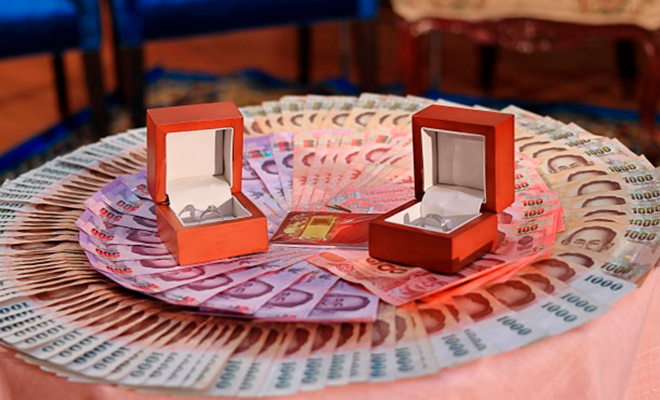Study Finds Dowry Was Paid In 95% Of Marriages In India, Despite Being Illegal Since 1961. Angry, But Not Surprised.

The patriarchy is a gift that keeps on giving, if you’re a guy. Don’t feel like scoring well in school? That’s okay, you’re in no danger of your right to education being snatched just because you don’t perform well and the money feels wasted on you. Don’t want to do any chores in the house? You don’t have to justify your lack of interest or laziness or feel guilty that someone else has to pick up after you. Can’t find a girl for yourself? Your parents will find a wife way out of your league for you, and make sure that she’s adept at looking after you, your parents, and your children, without you having ever raised a finger to help her. What’s more, when she comes, you can ask her to bring some of her parents’ lifelong savings and then some because isn’t she just super lucky she gets to marry you? Marriages may be made in heaven. But there’s a special place in hell for whoever thought of dowry.
In India, dowry was declared illegal and a punishable offence in 1961. Six decades ago sounds like a long time, but it was still late in its coming even then. Because countless women’s bodies, and their families’ bodies, have piled up in the wake of this regressive social evil. Even now, we get reports from rural areas of women being abused, raped tortured or burnt to death by their husbands and in-laws because they couldn’t afford to pay dowry. It’s almost like a business, where men and women in the marriage market are sold like commodities, and the more qualified and richer the guy and his family, the wider their mouths open to demand things like houses, cars, jewellery, cash and all the material comforts money can buy, in the name of giving the bride a happy married life.
And if you thought the custom of dowry is rampant in rural areas only, you’ve got another think coming. Thr rich and well-educated families are the one who have a chance to bring the system down but hold on to it with all their greed. It’s only done a tad more sophisticatedly and under the garb of “gifts willingly given for the bride’s happiness” instead of blatantly “dowry”.
You’d think that after being declared illegal, the incidences of accepting dowry would go down. However, a study conducted by the World Bank that spanned the immediate five decades following this law’s enactment, has reported that not only was dowry still a very practiced custom, but also that 95% of marriages in India had some form of dowry payment as part of it.
The study was conducted between 1961 and 2008, with data collected from 17 Indian states comprising 96% of India’s population. The focus was majorly rural areas since villages is where a huge chunk of the country’s population continues to reside. Three economists spearheaded this study—S Anukriti, Nishith Prakash and Sunghoh Kwon— and they collected information on the value of the dowry gifts received in some 40,000 marriages during the study period, in both cash and kind.
Now since, in Indian marriages, there’s also an exchange of gifts from both parties, the researchers made sure to calculate a ‘net dowry’, which was the difference amount between the total value of gifts given by the bride’s family to the groom’s and the groom’s to the bride’s.
Also Read: In UP, A Woman Was Gangraped And Tortured Over Dowry By Her Husband And In-Laws
Here are 5 key findings of this study:
1. In very few marriages, the money spent on gifts by the groom’s family was more than the money spent by the bride’s.
2. While the average net dowry had been “remarkably stable” over the study time period, some inflation was noted before 1975 and after 2000.
3. The groom’s family spent an average of INR 5000 on the gifts brought for the bride’s family. On the other hand, the bride’s family spent about INR 32,000 on the gifts for the groom’s family. This could mean that they brought more gifts, or expensive ones. By this calculation, the average net dowry came to about INR 27,000.
4. In 2007, the average net dowry was equivalent to 14% of annual household income in rural areas. Again, these are all average numbers because the researchers did not have access to a lot of data—such as household income and expenditure—to calculate just how relative the size of the dowry is to a family’s household income.
5. As a custom, dowry was found in all the major religious groups in India. However, Christians and Sikhs displayed a “striking increase in dowry”, with their’s being higher average dowries than in Hindus and Muslims.
While the study was only conducted based on data up until 2008, the economists have said that you can expect the trend to be pretty much the same. Why? Well, because there hasn’t been “dramatic changes or structural breaks in marriage markets, laws, human capital of men and women and women’s labour market outcomes” now, has there?
It’s shameful that despite all these laws in place, India stubbornly refuses to outgrow its regressive patriarchal customs and traditions. In fact, if anything, with the whole spectacle for social media that marriage has become, and the emphasis on ‘showing off’ ones wealth and riches, it’s further regressing into old practices. Something must be done.


















